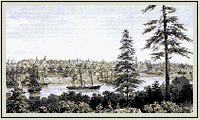1830s
 The Victorian era was inaugurated by accession of Victoria to the throne of Great Britain in 1837. The news took most of a year to arrive and spread among the fur trading posts of the Hudson's Bay Company, the only non-Aboriginal settlements in Oregon Territory, the vast area west of North America's Rocky Mountains and between California and Alaska.
The Victorian era was inaugurated by accession of Victoria to the throne of Great Britain in 1837. The news took most of a year to arrive and spread among the fur trading posts of the Hudson's Bay Company, the only non-Aboriginal settlements in Oregon Territory, the vast area west of North America's Rocky Mountains and between California and Alaska.
 The same summer as Victoria first sat on the throne, captain of the steamship Beaver, W.H.McNeill, was directed to examine the straits of Juan de Fuca to identify a site for a new headquarters for the Hudson's Bay Company on the Pacific. McNeill reported that he had found the site they were looking for. At the south end of Vancouver Island there was an excellent harbour he called Camosack:
The same summer as Victoria first sat on the throne, captain of the steamship Beaver, W.H.McNeill, was directed to examine the straits of Juan de Fuca to identify a site for a new headquarters for the Hudson's Bay Company on the Pacific. McNeill reported that he had found the site they were looking for. At the south end of Vancouver Island there was an excellent harbour he called Camosack:
Covered with wood to the extent of half a mile, interiorly, where the forest is replaced by a more open an beautifully diversified Country, presenting a succession of plains with groves of Oaks and pine trees for a distance of 15 or 20 miles....The plains are said to be fertile and covered with luxuriant vegetation.
The location for the future city of Victoria had been found. It would be confirmed by JamesDouglas five years later.
The Lekwammen people who occupied and owned what would become the site of Victoria, had intermittent contact with the traders of the HBC before 1837, both by occasional visits of their ships, and by traveling to Fort Langley, established in 1828 near the mouth of the Fraser River. More than 2,000 people at villages in Cadboro Bay, Esquimalt Harbour, and Discovery Island and gathering camps at every bay along the coast of Vancouver and San Juan Island, lived in what is now "Greater Victoria". They may well have heard about the "King Chautsh tyee klootchman" the "British queen" in the trading language Chinook, from the traders, but they had no idea how their destiny had been tied to that distant 'tyee'.